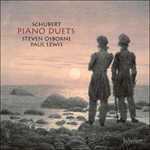The Allegro in A minor, D947 and the Rondo in A major, D951 were written in May and June 1828 respectively, and may well have been intended to form a two-movement sonata along the lines of Beethoven’s E minor Sonata Op 90. Rondo was published in December 1828, less than a month after Schubert died, but its A minor companion-piece did not see the light of day until 1840, when Anton Diabelli issued it under the heading of
Lebensstürme (‘The storms of life’)—a catchpenny title that belittles the stature of what is one of Schubert’s most imposing sonata movements. Its turbulent opening pages meet their obverse side in the serenity of a second subject given out in the manner of a distant chorale which leaves any notion of storms far behind. The piece as a whole is one that makes dramatic use of abrupt silences—nowhere more startlingly so than at the end of its first stage, where the music breaks off in mid-stream, only to be followed by an unceremonious plunge into a wholly unexpected key for the start of the central development section. The development is entirely based on the opening subject, which is transformed in its closing moments into a delicately tripping passage that throws the explosive start of the recapitulation into relief.
from notes by Misha Donat © 2010
L’Allegro en la mineur D947 et le Rondo en la majeur D951 furent écrits en mai et juin 1828, peut-être dans l’optique d’une sonate en deux mouvements, comme celle de l’op. 90 en mi mineur de Beethoven. Si le Rondo parut en décembre 1828, moins d’un mois après la mort de Schubert, son pendant en la mineur ne sortit pas de l’ombre avant 1840, quand Anton Diabelli le publia sous le titre de
Lebensstürme («Les tempêtes de la vie»)—un titre accrocheur qui flétrit ce qui est l’un des plus imposants mouvements de sonate schubertiens. Aux turbulentes pages d’ouverture s’oppose la sérénité d’un second sujet exposé à la manière d’un lointain choral et qui laisse derrière lui toute notion de tempêtes. Globalement, cette pièce use avec drame de brusques silences—nulle part de façon plus saisissante qu’à la fin de son premier volet, quand la musique s’interrompt en plein milieu pour plonger soudain dans une tonalité des plus inattendues au début du développement central. Ce dernier repose avant tout sur le sujet inaugural, métamorphosé, dans ses moments conclusifs, en un passage délicatement sautillant qui souligne le départ explosif de la réexposition.
extrait des notes rédigées par Misha Donat © 2010
Français: Hypérion
Das Allegro in a-Moll D947 und das Rondo in A-Dur D951 wurden im Mai und Juni 1828 komponiert und könnten durchaus als zweisätzige Sonate in der Art von Beethovens Sonate in e-Moll op. 90 gedacht gewesen sein. Das Rondo wurde weniger als einen Monat nach Schuberts Tod im Dezember 1828 veröffentlicht, das Begleitstück in a-Moll jedoch erst 1840, als Anton Diabelli es unter dem publikumswirksamen Titel
Lebensstürme herausgab, der diesem zu den eindrucksvollsten von Schuberts Sonatensätzen zählenden Werk kaum gerecht wird. Seine turbulente Einleitung findet ihr Gegenstück in der Heiterkeit eines zweiten Themas in der Stimmung eines aus der Ferne erklingenden Chorals, das jegliche Gedanken an einen Sturm weit hinter sich lässt. Insgesamt macht das Stück dramatischen Gebrauch von plötzlich einsetzendem Schweigen, und zwar am überraschendsten am Ende der ersten Stufe, wo die Musik unvermittelt abbricht, um dann ganz unfeierlich in eine vollkommen unerwartete Tonart für den Beginn des mittleren Durchführungsteils zu fallen. Die Durchführung baut vollständig auf dem einleitenden Thema auf, das in seinen Schlussmomenten in eine zart trippelnde, den explosiven Beginn der Reprise entspannende Passage verwandelt wird.
aus dem Begleittext von Misha Donat © 2010
Deutsch: Henning Weber


 Schubert: Piano Duets
Schubert: Piano Duets
